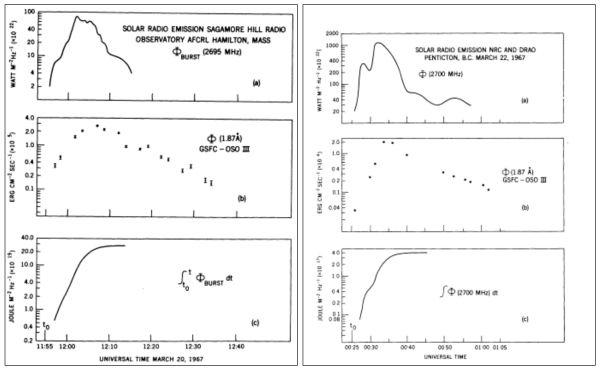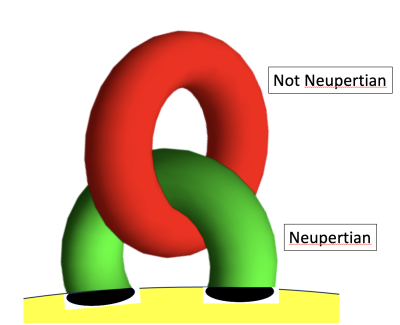Neupertianity: Difference between revisions
(No. 503 upload) |
|||
| (13 intermediate revisions by the same user not shown) | |||
| Line 1: | Line 1: | ||
{{Infobox Nugget | {{Infobox Nugget | ||
|name = Nugget | |name = Nugget | ||
|number = 503 | |||
|number = | |||
|first_author = Hugh HUDSON | |first_author = Hugh HUDSON | ||
|publish_date = August 25, 2025 | |publish_date = August 25, 2025 | ||
| Line 26: | Line 25: | ||
The soft X-ray datum here was a pioneering spectroscopic product of | The soft X-ray datum here was a pioneering spectroscopic product of | ||
Neupert's | Neupert's [https://en.wikipedia.org/wiki/OSO_3 OSO-III] | ||
[OSO-III] instrument; it is the "Fe feature" detectable above about | instrument; it is the "Fe feature" detectable above about | ||
10 MK, and representing Fe ions ionized down to at least their "He-like" | 10 MK, and representing Fe ions ionized down to at least their "He-like" | ||
state, ie an iron nucleus with only two electrons. | state, ie an iron nucleus with only two electrons. | ||
Such data have not really been obtained recently; OSO-III ended its mission | Such data have not really been obtained recently; OSO-III ended its mission | ||
in the 1960s. | in the 1960s and we've never had adequate imaging spectroscopy in this spectral band. | ||
== Significance == | == Significance == | ||
| Line 59: | Line 58: | ||
The configuration in Figure 2 has probably never been observed in the | The configuration in Figure 2 has probably never been observed in the | ||
solar corona, but it is not completely impossible. | solar corona, but it is not completely impossible. | ||
Fluids forming a [https://en.wikipedia.org/wiki/Trefoil_knot trefoil knot] | |||
pattern have actually been observed in laboratory | pattern have actually been observed in laboratory experiments (Ref. [2]). | ||
There is also substantial theoretical work (starting with | There is also substantial theoretical work (starting with | ||
[https://en.wikipedia.org/wiki/Vortex_theory_of_the_atom Kelvin], it turns out) | [https://en.wikipedia.org/wiki/Vortex_theory_of_the_atom Kelvin], it turns out) | ||
on various applications of these and more complex topological states. | on various applications of these and more complex topological states. | ||
As always, a stellar atmosphere has a | As always, a stellar atmosphere in a closed-field corona has a major distinction in the existence of its | ||
interface | interface layers between the very different photospheric and coronal plasma volumes. | ||
== Conclusions == | == Conclusions == | ||
The Neupert Effect is pervasive in solar flares because of mass ejection into closed | The Neupert Effect is pervasive in solar flares because of mass ejection into closed | ||
coronal field | coronal field regions ("evaporation"), where there is a subsequent delay caused by cooling | ||
and draining. | |||
The weird configuration in Figure 2 would allow truly isolated coronal plasmas to develop, | The weird configuration in Figure 2 would allow truly isolated coronal plasmas to develop, | ||
perhaps in different ways. | perhaps in different ways, by eliminating access to the mass reservoir (the chromosphere). | ||
The tension force from the ordinary anchored closed field (green) restrains the isolated coronal field (red). | |||
Of course any energy release in the red region might well drive magnetic reconnection that | |||
would spoil the cartoon! | |||
And, if this red-field heating were impulsive, ie on shorter time scales than the radiative | |||
time scale, it would still follow something like the Neupert Effect, but with the major distinction | |||
that there would be no mass reservoir available. | |||
== References == | == References == | ||
| Line 79: | Line 85: | ||
[1] [https://ui.adsabs.harvard.edu/abs/1968ApJ...153L..59N "Comparison of Solar X-Ray Line Emission with Microwave Emission during Flares"] | [1] [https://ui.adsabs.harvard.edu/abs/1968ApJ...153L..59N "Comparison of Solar X-Ray Line Emission with Microwave Emission during Flares"] | ||
[2] [https://ui.adsabs.harvard.edu/abs/2013NatPh...9..253K | [2] [https://ui.adsabs.harvard.edu/abs/2013NatPh...9..253K "Creation and dynamics of knotted vortices"] | ||
Latest revision as of 09:49, 11 September 2025
| Nugget | |
|---|---|
| Number: | 503 |
| 1st Author: | Hugh HUDSON |
| 2nd Author: | |
| Published: | August 25, 2025 |
| Next Nugget: | TBD |
| Previous Nugget: | Synchrotron Radiation and the Foundations for a Cosmic Bridge |
Introduction
The terminology of the "Neupert Effect" has entered the flare literature, both solar and stellar. Werner Neupert (Ref. [1]) had recognized something quite important in his 1967 paper, via the comparison of flare soft X-ray emission with radio signatures of sudden energy release. Figure 1 shows two examples from this early paper, comparing the time integral of microwave Synchrotron radiation with the growth of soft X-ray emission measure.
The soft X-ray datum here was a pioneering spectroscopic product of Neupert's OSO-III instrument; it is the "Fe feature" detectable above about 10 MK, and representing Fe ions ionized down to at least their "He-like" state, ie an iron nucleus with only two electrons. Such data have not really been obtained recently; OSO-III ended its mission in the 1960s and we've never had adequate imaging spectroscopy in this spectral band.
Significance
The Neupert Effect is often taken as evidence for the "thick-target model", frequently identified with John Brown. It is more general than that, however, since the general action of solar activity is heating. The heating of solar plasma at any height in the atmosphere tends to drive it upwards against its previous state of hydrostatic equilibrium; once in the corona, the cooling timescale becomes long and the result is "Neupertian", if the heated material gathers in closed magnetic fields. Thus any theory of solar activity predicts the Neupert Effect in some form. The alternative is upward flow on open field lines and rapid effective cooling due to expansion. Could one have closed fields totally in the corona, such that the heated plasma does not connect with the gas reservoir of the lower solar atmosphere? This is very unlikely, because it would suggest the outlandish configuration shown in Figure 2.
The configuration in Figure 2 has probably never been observed in the solar corona, but it is not completely impossible. Fluids forming a trefoil knot pattern have actually been observed in laboratory experiments (Ref. [2]). There is also substantial theoretical work (starting with Kelvin, it turns out) on various applications of these and more complex topological states. As always, a stellar atmosphere in a closed-field corona has a major distinction in the existence of its interface layers between the very different photospheric and coronal plasma volumes.
Conclusions
The Neupert Effect is pervasive in solar flares because of mass ejection into closed coronal field regions ("evaporation"), where there is a subsequent delay caused by cooling and draining. The weird configuration in Figure 2 would allow truly isolated coronal plasmas to develop, perhaps in different ways, by eliminating access to the mass reservoir (the chromosphere). The tension force from the ordinary anchored closed field (green) restrains the isolated coronal field (red). Of course any energy release in the red region might well drive magnetic reconnection that would spoil the cartoon! And, if this red-field heating were impulsive, ie on shorter time scales than the radiative time scale, it would still follow something like the Neupert Effect, but with the major distinction that there would be no mass reservoir available.
References
[1] "Comparison of Solar X-Ray Line Emission with Microwave Emission during Flares"

